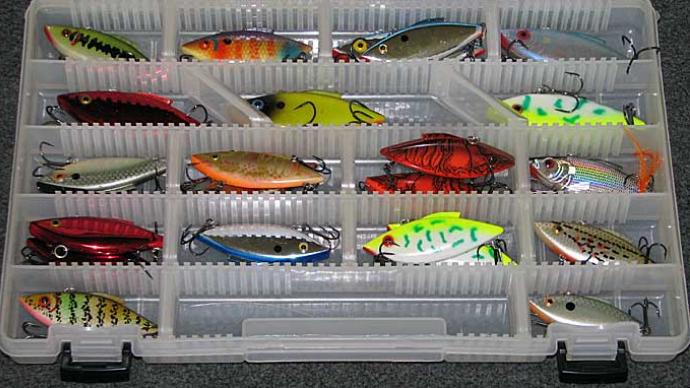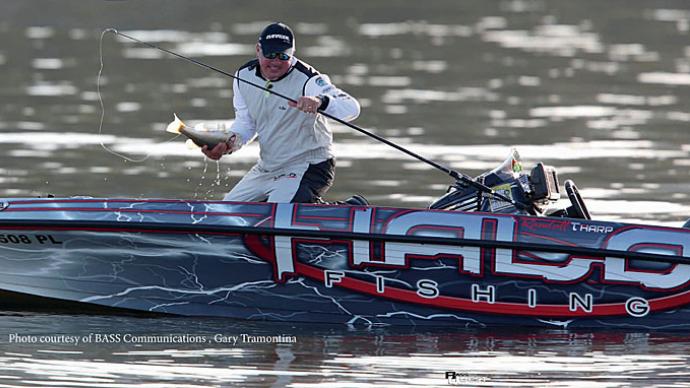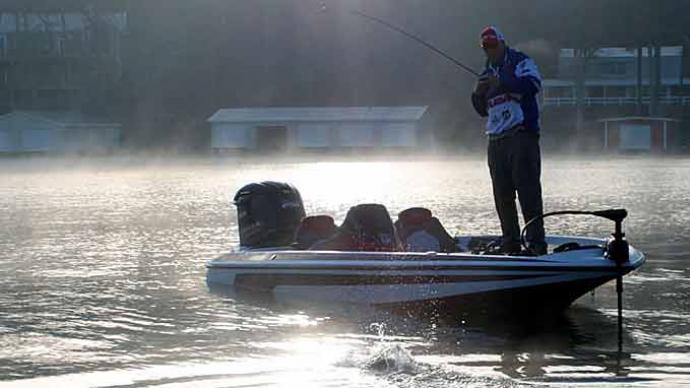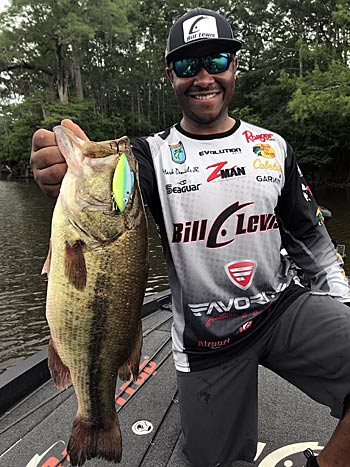
Prespawn bass congregate in large schools for a couple of reasons. First, spring’s constantly changing weather — warmups, cooldowns, and a steady parade of cold fronts — delay their migration from wintering holes to spawning flats. How much they pause usually depends on water depth. Deeper bass, which are less affected, keep swimming while more vulnerable shallower ones pause, causing congestion as one group catches the other. The other reason is that there are fewer spawning spots than wintering spots, creating a funneling action as spring progresses.
Prespawn bass congregations are bad and good. It’s bad that locating such a super spring spot may take a lot of time and many casts. It’s good that you don’t have to move far once you find one to keep catching bass. And there’s no more efficient way to do that than with a lipless crankbait.
Bass — largemouth, smallmouth, and spotted — love rattle-filled lipless crankbaits. Their size matches the most common baitfish, and they are offered in an almost infinite number of colors, making it easy to match the hatch when the water is clear or stand out when it’s muddy. Their tight shiver is at home in cold water, and their speed and sound shine when it’s at the warmest.
What makes lipless crankbaits bass-catching machines aren’t just guesses. Major League Fishing angler Mark Daniels Jr. said Rat-L-Traps, for example, have been scientifically studied, revealing that their vibrations closely match those actual baitfish make. “I think [the vibration is] the initial attraction,” he said. “Then you add the different sounds, and it gets even better.”
When to throw them
Bass anglers use lipless crankbaits year-round, even vertically jigging them through the ice. They are built to search for bass and generate reaction strikes. Those attributes are beneficial during prespawn.
Water temperature has always been the go-to measurement for determining the stage — prespawn, spawn, post-spawn — of springtime bass. For example, if it’s in the 50s, you can be confident that most bass are prespawn. And you better start sight fishing for spawners when it’s in the mid-60s. But it’s not the only factor to consider.
Daniels said that the day's length is also important, especially when fishing from mid-January through the end of March when daylight noticeably increases. He said that many bass anglers don’t bat an eye at it. “It’s one of the factors [bass] use to know spring is on the way,” he said.
Daniels said that the amount of daylight can be a truer indicator of bass activity than water temperature. “I’ve seen water temperature 45 to 46 degrees when they should be lethargic, and they were far from it,” he said. Most anglers would reach for slower bottom-bouncing lures, such as blade baits and jigs, with those water temperatures, regardless of what the calendar said. But those didn’t work in these situations. Instead, he said that the cold-blooded bass readily reacted to fast-moving lipless crankbaits.
Where to throw them
Lipless crankbaits’ versatility extends to the variety of different types of spots where they will produce bass. While one will work in nearly any scenario you can conceive, Daniels focuses on three during the prespawn.
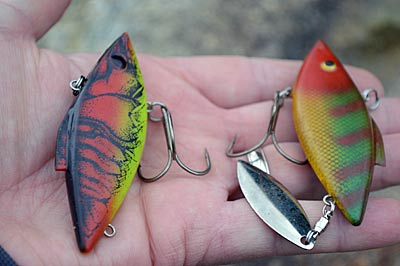
Submerged aquatic vegetation — milfoil, hydrilla, take your pick — is the classic spot for fishing lipless crankbaits. These beds produce during prespawn, primarily when located on points or along the outside edge of spawning flats. Of all the treble-hooked hard baits, Daniel said lipless crankbaits cut through aquatic vegetation best, giving him the chance to make more presentations and catch more bass in a day.
Take time to bring your lipless crankbaits past points and through pockets along the vegetation bed’s edges. And cast at each from different angles; sometimes, specific ones produce more bites. Don’t be afraid to cast into the bed. Openings, rock piles, and scattered logs and stumps, many of which aren’t visible, will concentrate bass.
Channel swing banks also grab Daniels’ attention. They offer the magic combination of a shallow flat and steep drop-off. But their biggest attraction for reservoir bass is directional, he said. They use creek channels as highways, following them from deep winter spots to shallow spawning flats. He’ll use his lipless crankbaits to intercept them along the way, especially where channels brush against the bank. And once you find them, you can use changes in weather, such as moving shallower with consistently warm weather, to stay with them as they advance along the channel.
During prespawn, Daniels also searches out transition banks, planting plenty of presentations on each that he finds. He said they don’t always immediately stand out, but any change in bottom composition, such as mud to rock, small rocks to big rocks, or sand to wood, will concentrate springtime bass. It gives them something to relate to and creates what he calls a trapping point. Bass push baitfish and crawfish against the edge, making it easier for them to feed.
How to throw them
Wringing all the bass-catching power from a lipless crankbait starts with how it’s retrieved, which can be done in myriad ways. Daniels said springtime bass seem to want something different every day due to rapidly changing conditions. “You just never really know,” he said.
Daniels continuously varies his retrieve, fishing his lipless crankbait from just under the surface to the bottom. In warm water and under low light, turning your reel as fast as possible, a straight retrieve will push bass to crush your lure. Slow your retrieve, and lipless crankbaits become a great slow-rolling lure.
Don’t be afraid to add pauses into your retrieve. Nearly all lipless crankbaits sink, so every time you stop, it drifts down and back, forcing a following bass to react with a strike. You’ll generate a similar response by pausing longer to allow your lipless crankbait to sink into submerged aquatic vegetation. With the help of no-stretch braided line, pop it free before resuming your retrieve.
Lipless crankbaits even produce when fished along the bottom. A simple slow retrieve will keep them there, but Daniels likes to show bass something different, hopping his along the bottom, 6- to 10-inches at a time. “They like that,” he said. Maintaining bottom contact during the coldest water temperatures of prespawn is critical. He said that crawfish will be a big part of the bass’s menu, so the closer you can keep your lure to the bottom, the more it will look like one.
Regardless of his fishing depth, Daniels uses a 7-foot, 2-inch medium-heavy Favorite Sick Stick casting rod; its slow action creates a parabolic bend under load, keeping trebles locked into surging and jumping bass. He matches it with a Bass Pro Shops Johnny Morris Platinum Signature baitcasting reel with a 6.8:1 gear ratio. He always starts by spooling it with 15-pound test Seaguar AbrazX fluorocarbon line. But depending on water color and cover, he’ll drop to as little as 12-pound test to make his line less visible or step up to as much as 20-pound test to handle big bass and thick cover. In addition to being stronger, the 20-pound test’s larger diameter offers plenty of water resistance, keeping his lipless crankbait running shallow. Smaller pound-test lines have the opposite effect. “From the surface to 3 feet deep, it makes no sense for me to use 12 [pound test],” he said. “I’m going to throw 20-pound test.”
Which ones to throw
It’s easy to spin out when choosing a lipless crankbait, especially when considering how many colors they are made. Daniels recommends pumping the brakes and keeping it simple. He feels prepared for any situation with ones painted like crawfish, shad, and bluegill in his boat. “Coast to coast, they will get it done,” he said.
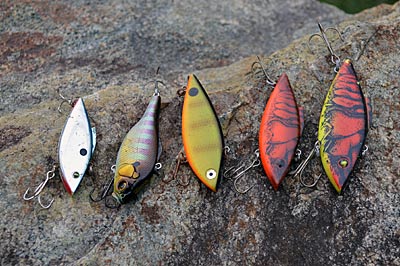
Daniels’ crawfish colors all sport some variation of red. Some of his favorite Rat-L-Traps are Red Craw and California Craw. His bluegill-colored ones have purple, chartreuse, and orange. He also includes ones with chartreuse bellies and blue backs. That’s a popular choice on shad lakes, but don’t limit yourself to fishing that pattern only there. “It mimics a bluegill, too,” he said. And it’s hard to beat chrome, with either a blue or black back, when bass are munching on shad. “That has been smashing them since the 1960s,” he said.
Lipless crankbaits are offered in many sizes, but most bass anglers prefer the 1/4-, 1/2- and 3/4-ounce models. And of those, the 1/2-ounce one sees the most action. At about 3 inches long, it matches most crawfish and baitfish that bass come across. But it’s helpful to have a handful of the smaller and larger ones to match the hatch or depth extremes when needed.
While lipless crankbaits fresh from the package will catch bass, Daniels prefers to make a few modifications. Sometimes he’ll add a small willow-leaf or Colorado blade and ball-bearing swivel in place of the rear treble hook. “It’s a quick and easy change,” he said. But, he said, it can significantly impact, helping generate more bites from pressured bass by giving them a different look.
Daniels’ other modifications involve hooks. If he’s fishing around wood, he removes his lipless crankbait’s rear hook, reducing the chance it snags, and changes the front hook to one size larger, ensuring it continues to hook well. So, on a 1/2-ounce Rat-L-Trap, he puts a No. 2 treble in place of the No. 4 stock hook.
The style of the treble hook matters to Daniels, too. In winter, he uses an extra-wide gap hook such as Owner’s ST-56. They hold well in cold-water bass, which are most likely to inhale his lipless crankbait. But as the water warms and clears, bass see better, and more start slapping at his lure instead of eating it. It’s then that he switches to a round-bend style of hook such as Owner’s ST-36. It features more space between the point and shank, increasing the chance of grabbing bass that only buzz his lure.


